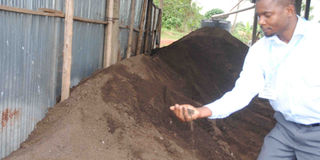Government to promote use of fertilisers

Manure made from garbage is a way to make more fertilisers accessible to farmers in Uganda. Photo by Martin Ssebuyira
What you need to know:
Against this backdrop, the government has embarked on a campaign to promote increased use of fertilisers among smallholder farmers to tackle the declining soil fertility that is affecting crop yields. These yields are at 30 per cent of the potential they could be.
Over time, Ugandan soils have continued to lose nutrients without them being replenished. As a result, soil fertility is low and declining, the crop yields are at less than their potential.
This is coupled with the fact that Uganda has the lowest level of fertiliser use in the world, at less than two kilogrammes of nutrient per hectare per year, compared to Africa’s average of 89kg per hectare per year.
Against this backdrop, the government has embarked on a campaign to promote increased use of fertilisers among smallholder farmers to tackle the declining soil fertility that is affecting crop yields. These yields are at 30 per cent of the potential they could be.
Recommended average
Therefore, it is important that ways are sought to make fertilisers available. They should be both affordable and easily accessed by farmers for use on a sustainable basis.
The Ministry of Agriculture, Animal Industry and Fisheries (MAAIF) will also incorporate trainings of farmers and produce suppliers in the plan.
Tress Bucyanayandi, the minister, said in a speech that was read for him by Komayombi Bulegeya, MAAIF’s Commissioner, Crop Protection, who represented him at the official launch.
He pointed out that Uganda is signatory to the Abuja Declaration, which was passed in 2006, that recommended an increase in fertiliser use by African countries to at least 50kgs of nutrient per hectare per year within five years.
“The recommended average for Uganda is at least 200kgs of nutrient per hectare per year,” Buchanayandi revealed.
In his remarks, Bulegeya observed that while fertilisers could address the declining land productivity, the use remains the lowest.
Removal of constraints
Therefore, actions to make quality fertilisers available to all farmers will entail addressing the constraints in supply and demand.
The constraints on the supply side include low volume procurements, poor network of stockists for distribution, poor quality or fake fertilisers, and no exploitation of local resources to make fertilisers.
Constraints on the demand side include poor product knowledge at farmer level, poor access to fertilisers, low purchasing power of the farmers, and poor
So, the removal of the constraints will require actions by the public sector to create an enabling environment for the private sector to operate, as well as regulate the fertiliser sector. National policy and regulations are being considered by the Cabinet and a decision is expected soon.




